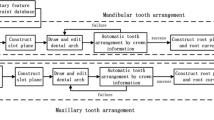Abstract
High-accuracy geometrical models of a subject’s mandibular and maxillary teeth are combined with recordings of natural chewing trajectories of the same subject to obtain a subject-specific virtual model of mastication—the virtual masticator. The virtual masticator and a shape-optimization algorithm, which is based on removing collisions occurring between a generic maxillary tooth/teeth and the mandibular antagonists during mastication, is used to automatically reconstruct functional tooth surfaces. The process was tested using a chewing trajectory stemming from recordings made of an individual while eating elastic-type foods, a generic maxillary tooth, and the mandibular second molar of that individual. Comparing the obtained results with the actual tooth, the errors within the occlusal and functional regions of the the right second maxillary molar range between −90 and 200 μm and these errors do not change any more after three chewing cycles. These results indicate that a small number of chewing cycles is sufficient to remove occlusal interferences in the virtual tooth model. Such automatically reconstructed tooth surfaces can provide guidance during the design stage of dental fixed restorations manufactured using computer-aided design and manufacturing (CAD/CAM) systems and provide additional information for the design of dental implants or bridges.






Similar content being viewed by others
References
Bisler, A., U. Bockholt, and G. Voss. The virtual articulator—applying VR technologies to dentistry. In: Proceedings of the Sixth International Conference on Information Visualisation, 2002.
Bourdiol, P., and L. Mioche. Correlations between functional and occlusal tooth-surface areas and food texture during natural chewing sequences in humans. Arch. Oral Biol. 45: 691–699, 2000.
van Essen, N., I. Anderson, P. Hunter, J. Carman, R. Clarke, and A.J. Pullan. Anatomically based modelling of the human skull and jaw. Cells Tissues Organs 180(1): 44–53, 2005.
Every, R. Significance of tooth sharpness for mammalian, especially primate, evolution. Contrib. Primatol. 5: 293–325, 1975.
Foster, K., A. Woda, and M.Peyron. Effect of texture of plastic and elastic model foods on the parameters of mastication. J. Neurophysiol. 95(6): 3469–3479, 2006.
Hatch, J., R. Shinkai, S. Sakai, J. Rugh, and E. Paunovich. Determinants of masticatory performance in dentate adults. Archives of Oral Biology 46(7): 641–648, 2000.
Ichim, I., M. Swain, and J.A. Kieser. Mandibular biomechanics and development of the human chin. J. Dent. Res. 85(7): 638–642, 2006.
Julien, K., P. Buschang, G. Throckmorton, and P. Dechow. Normal masticatory performance in young adults and children. Arch. Oral Biol. 41: 69–75, 1996.
Kamegawa, M., M. Nakamura, K. Kitahara, H. Ohtomo, T. Hasegawa, T. Nakakura, and S. Tsutsumi. 3D morphological assessment of occlusal treatment by measuring dental casts with a micro-focus X-ray CT. J. Oral Rehabil. 35(5): 382–389, 2008.
Karlsson, S. Recording of mandibular movements by intraorally placed light emitting diodes. Acta Odontol. Scand. 35(1): 111–117, 1977.
Korioth, T., D. Romilly, and A. Hannam. Three-dimensional finite element stress analysis of the dentate human mandible. Am. J. Phys. Anthropol. 88(1):69–96, 1992.
Koseki, M., A. Niitsuma, N. Inou, and K. Maki. Three-dimensional display system of individual mandibular movement. In: Proceedings of The First International Conference on Complex Medical Engineering (CME2005), pp. 249–254, 2005.
Luke, D., and P. Lucas. Chewing efficiency in relation to occlusal and other variations in the natural human dentition. Brit. Dent. J. 159: 401–403, 1985.
Maletsky, L., J. Sun, and N. Morton. Accuracy of an optical active-marker system to track the relative motion of rigid bodies. J. Biomech. 40(3): 682–685, 2007.
Maruyama, T., K. Higashi, T. Mizumori, S. Miyauchi, and T. Kuroda. Clinical studies on consistency of chewing movement. Chewing path for the same food. J. Osaka Univ. Dent. Sch. 25: 49–61, 1985.
McDermott, I., and R. Roewe. The Hardy chew-in technique: a modified procedure. J. Prosthet. Dent. 48(2): 202–5, 1982.
Mesqui, F., F. Kaeser, and P. Fischer. Real-time, noninvasive recording and three-dimensional display of the functional movements of an arbitrary mandible point. Proc. SPIE 602: 77–84, 1985.
Meyer, F. The generated path technique in reconstruction dentistry, Parts I and II. J. Prosthet. Dent. 9: 354–366, 1959.
Mohamed, S., J. Schmidt, and J. Harrison. Articulators in dental education and practice. J. Prosthet. Dent. 36(3): 319–25, 1976.
Motohashi, N., and T. Kuroda. A 3D computer-aided design system applied to diagnosis and treatment planning in orthodontics and orthognathic surgery. Eur. J. Orthodont. 21(3): 263–274, 1999.
Murphy, T. The timing and mechanism of the human masticatory stroke. Arch. Oral Biol. 10: 981–993, 1965.
Olthoff, L., J. van der Zel, W. de~Ruiter, S. Vlaar, and F. Bosman. Computer modeling of occlusal surfaces of posterior teeth with the CICERO CAD/CAM system. The J. Prosthet. Dent. 84(2): 154–162, 2000.
Omar, S., J. McEwen, and S. Ogston. A test for occlusal function. The value of a masticatory efficiency test in the assessment of occlusal function. J. Orthodont. 14: 85–90, 1987.
Palin, W.M., and F.J.T. Burke. Trends in indirect dentistry: 8. CAD/CAM technology. Dent. Update 32(10): 566–572, 2005.
Pameijer, J., I. Glickman, and F. Roeber. Intraoral occlusal telemetry - III. Tooth contacts in chewing, swallowing and bruxism. J. Periodontol. 40: 253–261, 1969.
Röhrle, O., J. Waddell, K. Foster, H. Saini, and A. Pullan. Using a motion capture system to record dynamic articulation for application in CAD/CAM software. J. Prosthodont. (accepted).
Teaford, M., M. Smith, and M. Ferguson. Development Function and Evolution of Teeth. Cambridge University Press, 2000.
Wiles, A., D. Thompson, and D. Frantz. Accuracy assessment and interpretation for optical tracking systems. Proc. SPIE 5367: 421–432, 2004.
Acknowledgment
This work was funded through the Foundation for Research in Science and Technology (FRST) under Contract Number UOAX0406. The author O.R. would also like to thank the German Research Foundation (DFG) for financial support of the project within the Cluster of Excellence in Simulation Technology (EXC 310/1) at the University of Stuttgart.
Author information
Authors and Affiliations
Corresponding author
Rights and permissions
About this article
Cite this article
Saini, H., Wadell, J.N., Pullan, A.J. et al. Automatically Generating Subject-specific Functional Tooth Surfaces Using Virtual Mastication. Ann Biomed Eng 37, 1646–1653 (2009). https://doi.org/10.1007/s10439-009-9725-y
Received:
Accepted:
Published:
Issue Date:
DOI: https://doi.org/10.1007/s10439-009-9725-y




